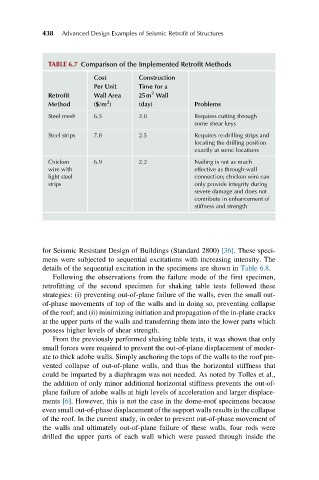Page 495 - Advanced Design Examples of Seismic Retrofit of Structures
P. 495
438 Advanced Design Examples of Seismic Retrofit of Structures
TABLE 6.7 Comparison of the Implemented Retrofit Methods
Cost Construction
Per Unit Time for a
2
Retrofit Wall Area 25m Wall
2
Method ($/m ) (day) Problems
Steel mesh 6.5 2.0 Requires cutting through
some shear keys
Steel strips 7.8 2.5 Requires re-drilling strips and
locating the drilling position
exactly at some locations
Chicken 6.9 2.2 Nailing is not as much
wire with effective as through-wall
light steel connection; chicken wire can
strips only provide integrity during
severe damage and does not
contribute in enhancement of
stiffness and strength
for Seismic Resistant Design of Buildings (Standard 2800) [36]. These speci-
mens were subjected to sequential excitations with increasing intensity. The
details of the sequential excitation in the specimens are shown in Table 6.8.
Following the observations from the failure mode of the first specimen,
retrofitting of the second specimen for shaking table tests followed these
strategies: (i) preventing out-of-plane failure of the walls, even the small out-
of-phase movements of top of the walls and in doing so, preventing collapse
of the roof; and (ii) minimizing initiation and propagation of the in-plane cracks
at the upper parts of the walls and transferring them into the lower parts which
possess higher levels of shear strength.
From the previously performed shaking table tests, it was shown that only
small forces were required to prevent the out-of-plane displacement of moder-
ate to thick adobe walls. Simply anchoring the tops of the walls to the roof pre-
vented collapse of out-of-plane walls, and thus the horizontal stiffness that
could be imparted by a diaphragm was not needed. As noted by Tolles et al.,
the addition of only minor additional horizontal stiffness prevents the out-of-
plane failure of adobe walls at high levels of acceleration and larger displace-
ments [6]. However, this is not the case in the dome-roof specimens because
even small out-of-phase displacement of the support walls results in the collapse
of the roof. In the current study, in order to prevent out-of-phase movement of
the walls and ultimately out-of-plane failure of these walls, four rods were
drilled the upper parts of each wall which were passed through inside the

